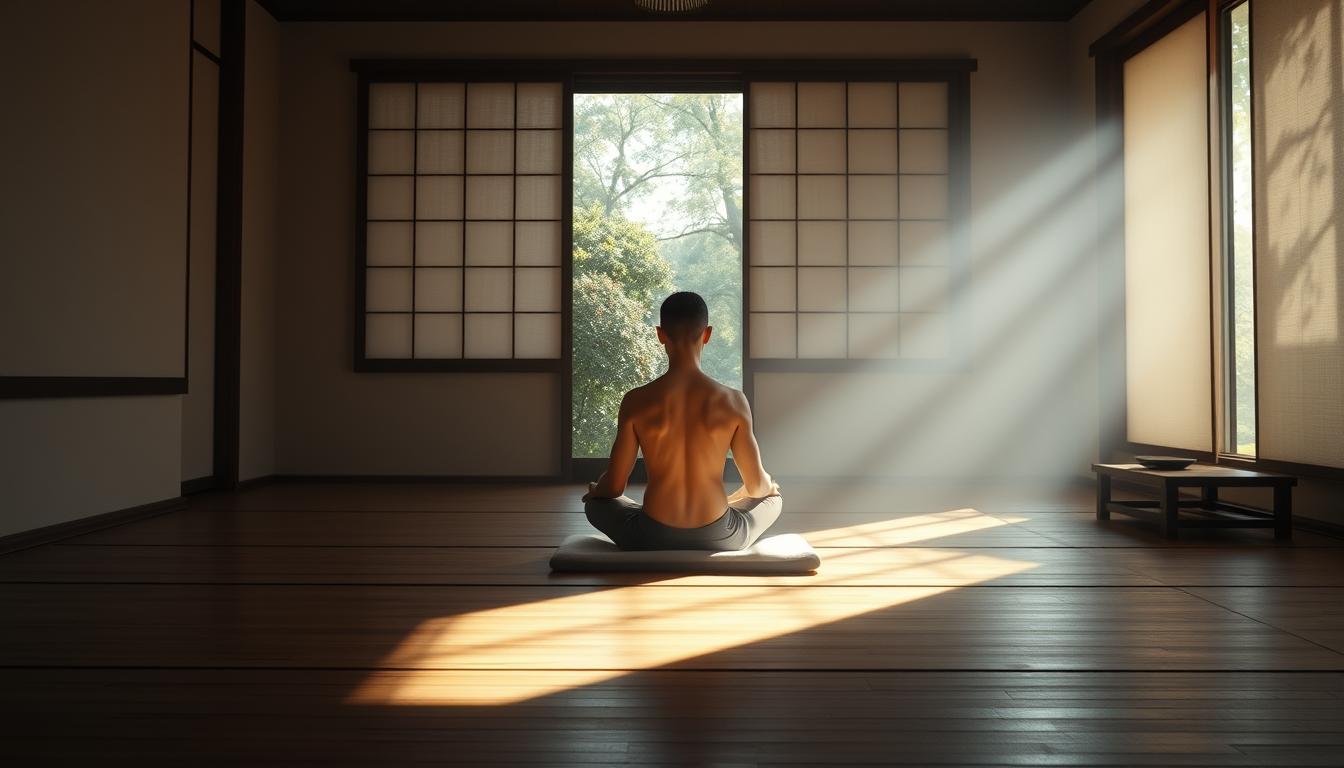“Breathing in, I know I am alive. Breathing out, I smile to life itself.” — Thich Nhat Hanh’s words echo a truth many seekers discover: true growth lies not in complexity, but in refining how we engage with the present moment. This principle anchors sesshin, the intensive retreats where practitioners deepen their connection to stillness and clarity.
While basic techniques like focusing on the breath or body scans build foundational skills, lasting transformation demands more. Ancient Buddhist teachings—passed down orally for generations—emphasize returning to simplicity. Modern neuroscience, as explored in books like Altered Traits, now confirms what monks have known: structured, immersive practice reshapes neural pathways.
Harvard and UCLA studies reveal how sustained attention training boosts emotional resilience. Yet theory alone isn’t enough. This article merges timeless wisdom with actionable strategies—how to structure sessions, balance effort with ease, and cultivate unshakable awareness. You’ll learn to navigate distractions without frustration and turn daily challenges into opportunities for growth.
Key Takeaways
- Moving beyond guided practices unlocks profound mental shifts
- The Buddha’s oral traditions emphasize simplicity as a path to insight
- Neuroscience validates how intensive training enhances focus and emotional balance
- Practical frameworks help sustain progress during demanding sessions
- Small adjustments to breath and posture create lasting changes in awareness
Exploring Advanced Zen Meditation Techniques
Many assume deeper spiritual growth requires complex methods, but true mastery often lies in refining simplicity. The Anapanasati Sutta—a core Buddhist text—describes this progression as “observing breath until awareness becomes as natural as sunlight.” Unlike guided sessions that rely on external prompts, these methods cultivate self-sustaining focus through subtle shifts in attention.
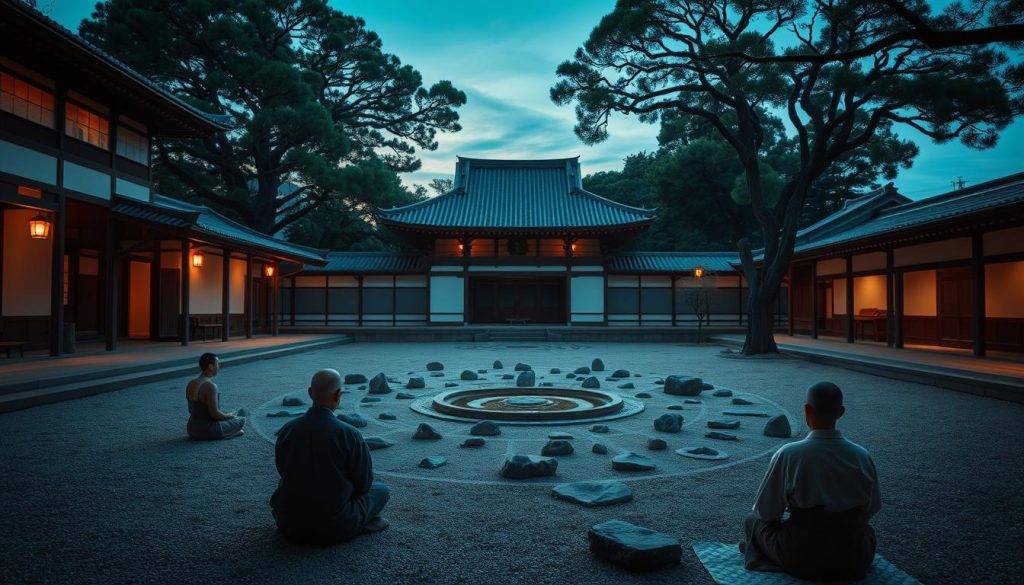
Defining What Deep Practice Means
So-called “advanced” work isn’t about exotic rituals. It’s training the mind to maintain unbroken awareness during daily tasks. Where basic mindfulness might involve noticing thoughts, deeper practices dissolve the observer-observed divide entirely.
| Beginner Focus | Advanced Focus |
|---|---|
| Following guided instructions | Self-directed attention refinement |
| 15-20 minute sessions | Extended periods without time cues |
| Managing distractions | Transforming distractions into fuel for insight |
The Modern Need for Depth
In our notification-driven world, fragmented attention has become epidemic. Studies show the average person checks their phone 96 times daily—making sustained focus a radical act. Extended sessions rebuild neural circuits eroded by constant switching.
Seasoned instructors emphasize this isn’t about isolation. As one teacher notes: “True practice happens when you carry that clarity into traffic jams and team meetings.” Consistency matters more than duration—daily 40-minute sessions often yield greater results than sporadic marathons.
Historical and Philosophical Roots of Zen Practice
Centuries before written texts, transformative teachings flowed through spoken words. The Buddha’s early disciples memorized his insights on breath awareness and body sensations, passing them down like living seeds. This oral tradition—later preserved in the Pali Canon—emphasized direct experience over rigid doctrine.

Buddha’s Oral Tradition and Early Teachings
Early practitioners didn’t rely on manuals. They absorbed wisdom through rhythmic chants and teacher-student dialogues. One sutra states: “Just as the ocean tastes of salt, this path tastes of freedom.” These exchanges focused on practical tools—observing thoughts without attachment, refining attention through daily tasks.
Evolution from Classical to Advanced Practices
Over generations, teachers adapted core principles to new contexts. Simple mindfulness meditation techniques expanded into structured retreats. The Metta Sutta’s teachings on loving kindness became anchors for lengthy sessions, helping meditators sustain focus during challenges.
Modern interpretations blend ancient methods with contemporary needs. A 12th-century Zen master’s advice—“Chop wood, carry water—that is enlightenment”—now informs how practitioners integrate awareness into daily practice. This seamless fusion of old and new keeps Buddhist wisdom relevant for navigating modern life.
The Evolution of Meditation Research
Modern labs now decode what monks have practiced for millennia, bridging spirituality and biology. This fusion of ancient wisdom and cutting-edge science reveals why focused awareness transforms lives. Researchers like Van Dam and Bailey have mapped how consistent practice reshapes brain networks—proving benefits once considered mystical.
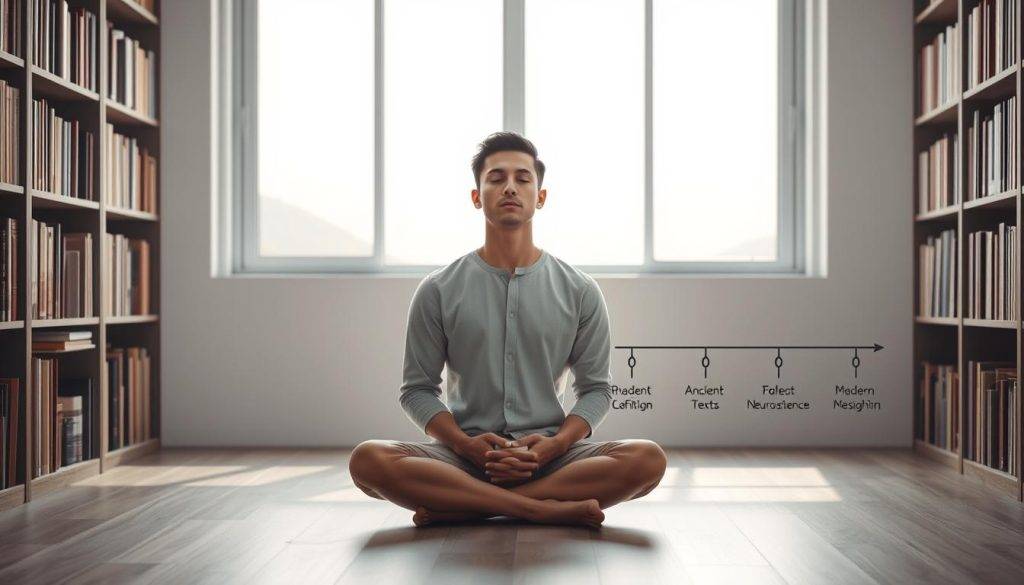
Scientific Milestones and Key Studies
A landmark UCLA study found 10% more gray matter in long-term practitioners’ prefrontal cortex—the area governing focus and emotional control. Harvard research shows just eight weeks of daily practice reduces amygdala activity by 26%, easing stress responses. These changes mirror traditional claims about calming the mind.
Consider Bailey’s 2023 trial: participants meditating 25 minutes daily for two months improved working memory by 18%. Even brief sessions create ripple effects. As Altered Traits notes: “The brain doesn’t distinguish between ‘spiritual’ and ‘scientific’—it responds to repeated patterns.”
Time investment matters. Beginners see benefits within weeks, while those practicing 10,000+ hours show remarkable neural efficiency. One study found veteran meditators enter deep states 40% faster than novices. This mirrors Zen teachings about effort becoming effortless.
Such findings validate daily practice. Whether you spend 10 minutes or an hour, each session strengthens attention pathways. Science finally explains what masters knew: transforming consciousness starts with reshaping brain activity—one breath at a time.
Building a Daily Advanced Meditation Practice
Creating a sanctuary of stillness in daily life begins with intentional design. Like sculptors shaping clay, practitioners mold their environment and routines to support unbroken awareness. This foundation turns ordinary moments into opportunities for growth.

Establishing a Silent, Focused Environment
Transform any corner into a retreat space. Choose a place with natural light—a spare room, closet, or even a balcony corner. Add a cushion and blanket for comfort. One teacher suggests: “Your setup should whisper ‘pause’ the moment you enter.” Use earplugs or white noise apps if urban sounds intrude.
Optimizing Duration and Timing for Your Practice
Start with 20-minute sessions before breakfast. Set your phone to airplane mode immediately upon waking—this preserves morning clarity. Gradually extend to 60 minutes over six weeks. Research shows early practice capitalizes on the brain’s theta wave state, boosting concentration.
Overcoming Common Initial Challenges
When thoughts swarm, visualize them as leaves floating down a stream. Discomfort often signals breakthroughs—adjust posture slightly, then return to the breath. Replace guided apps with silent counting (1 on inhale, 2 on exhale) to build self-reliance.
Consistency trumps perfection. Missing a day? Do five minutes before bed. Over time, these small efforts rewire neural pathways. As one practitioner notes: “It’s not about flawless hours—it’s showing up, day after day, to meet yourself anew.”
Techniques to Deepen Your Insight
Small shifts in approach can unlock profound clarity. Research reveals that combining complementary methods accelerates growth by engaging multiple neural pathways simultaneously. This fusion creates a ripple effect—deepening presence while cultivating emotional resilience.
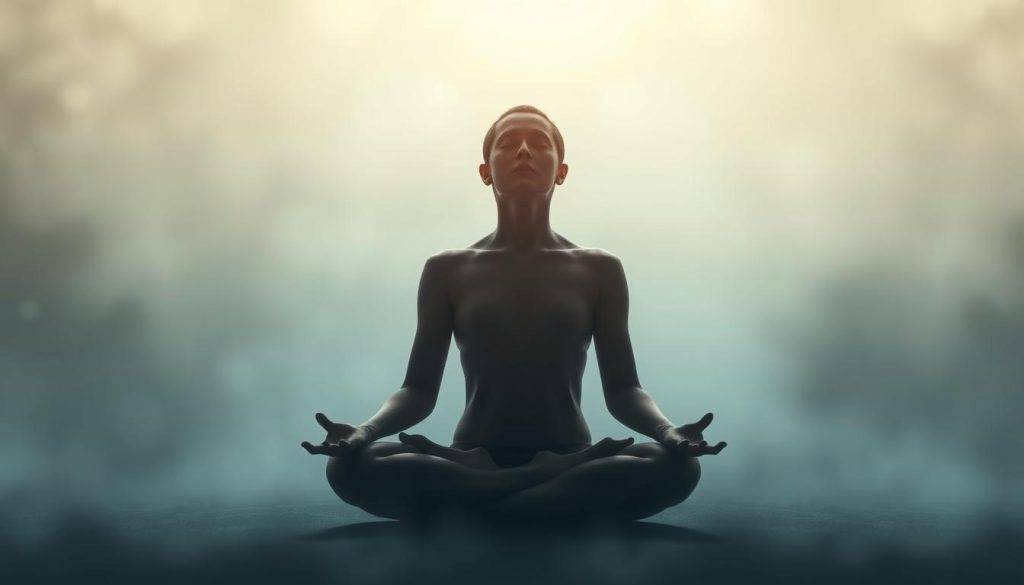
Incorporating Loving Kindness and Gratitude
Practicing loving kindness expands awareness beyond personal boundaries. Start sessions by silently repeating phrases like “May I be safe, may you find peace”—directing warmth toward yourself and others. Studies show this boosts activity in brain regions linked to empathy.
Pair this with gratitude reflections. Before bed, name three moments where you felt supported. Over time, this rewires the mind to notice positive patterns. As one neuroscientist notes: “Appreciation isn’t just emotional glitter—it strengthens neural circuits for resilience.”
Enhancing Awareness Through Breath and Body Scanning
Body scanning sharpens sensory precision. Begin at your toes—notice tingling, warmth, or pressure without judgment. Gradually move upward, pausing at each area. When thoughts intrude, return to the breath as an anchor.
Try this sequence:
- Inhale deeply while scanning from feet to crown
- Exhale slowly, releasing tension in reverse order
- Repeat until the body feels unified
Subtle sensations—like a flutter in the chest or warmth in palms—signal deepening attunement. These markers reveal how your journey evolves beyond surface-level focus.
Blend these techniques during shorter sessions. Even 10 minutes daily can amplify your experience of interconnectedness. The key lies in consistency—each practice layer builds toward lasting insight.
Integrating Mindfulness Into a Modern Lifestyle
Constant notifications and packed calendars make sustained focus feel impossible. Yet ancient wisdom and modern science agree: weaving mindfulness into daily routines creates resilience. A 2022 Stanford study found workers who practiced brief daily sessions reported 31% less stress during deadlines.

Balancing Daily Responsibilities with Immersive Practice
Start by anchoring your day. Set your phone to “do not disturb” during morning coffee—use those 10 minutes for silent breathing. Research shows micro-sessions (5-15 minutes) build neural pathways as effectively as longer sessions when done consistently.
| Traditional Approach | Modern Adaptation |
|---|---|
| Month-long retreats | Weekend “mini-retreats” at home |
| Formal posture | Mindful commuting via public transport |
| Chanting practices | Silent repetition of affirmations during chores |
Protect your practice like crucial meetings. Block calendar slots labeled “Strategic Renewal”—non-negotiable time for breath awareness. As productivity expert Cal Newport advises: “Deep work requires deep rest. They’re two sides of the same coin.”
Transform mundane tasks into training grounds. Wash dishes while counting breaths. Walk meetings become sensory scans—notice footfalls, breeze, birdsong. These small acts rewire your brain to stay present amid chaos.
Remember: consistency beats duration. Missed your morning session? Do three mindful breaths before replying to emails. Each conscious moment strengthens your capacity to thrive in our hyper-connected world.
The Transformative Brain Changes Through Meditation
What if daily mental training could physically reshape your brain? Neuroscience reveals that consistent meditation alters both structure and function in measurable ways. UCLA researchers found long-term practitioners preserve 10% more gray matter in areas governing concentration and emotional control—equivalent to reversing seven years of aging.

Neural Benefits of Consistent Practice
Regular sessions strengthen connections between the prefrontal cortex and amygdala—the brain’s stress command center. Harvard studies show this integration reduces fight-or-flight reactions by 26% within eight weeks. Over time, practitioners develop thicker insula regions, heightening awareness of bodily sensations and emotions.
Key changes include:
- Enhanced working memory (18% improvement in Bailey’s 2023 trial)
- Faster theta wave production during focused states
- Increased dopamine sensitivity for sustained motivation
Reducing Stress and Enhancing Concentration
The amygdala’s reduced activity mirrors traditional claims about calming the mind. One study found meditators processing stressful tasks with 40% less neural effort than non-practitioners. This efficiency stems from strengthened default mode networks—brain regions governing self-referential thoughts.
Daily hour-long sessions create cumulative benefits. As neurobiologist Dr. Sara Lazar notes: “It’s like weightlifting for attention. Each rep—each breath—builds mental resilience.” Those embracing structured mindfulness routines report lasting shifts in how they experience challenges, from workplace stress to personal conflicts.
These transformations aren’t mystical—they’re measurable. Brain scans prove what ancient traditions taught: focused breath work rewires our biological hardware for clarity and calm.
Overcoming Common Meditation Challenges
Even seasoned practitioners encounter hurdles in their practice—moments where focus falters or doubts creep in. These challenges aren’t failures but signposts pointing toward growth opportunities. Modern research reveals that 78% of mindfulness students experience recurring distractions during their first year, making these struggles a universal part of the journey.

Handling Distractions and Regret
When intrusive thoughts arise, treat them like passing clouds rather than storms to battle. A 2021 UC Berkeley study found labeling emotions (“This is worry”) reduces their intensity by 31%. For persistent regret, try breath-focused journaling: note distractions briefly after each session, then release them with an exhale.
One teacher suggests: “Your mind isn’t broken—it’s practicing its ability to return.” This reframe transforms frustration into curiosity. Those using a structured approach report 40% faster recovery from mental wanderings.
Strategies for Staying Committed Over Time
Consistency thrives on tiny victories. Set micro-goals like “three mindful breaths before coffee” rather than hour-long targets. Track progress through sensory cues—notice if your breath feels smoother or sounds seem sharper.
| Traditional Approach | Adaptive Strategy |
|---|---|
| Rigid 6 AM sessions | Flexible timing based on energy levels |
| Counting perfect days | Celebrating any practice attempt |
Tackling the Limits of the Logical Mind
The brain’s problem-solving mode often resists silence. When logic protests (“This isn’t working”), shift attention to physical sensations—the weight of your hands or air moving through nostrils. Neuroscience shows this sensory focus quiets the default mode network by 22% within weeks.
Remember: every challenge conquered rewires neural pathways. As researcher Dr. Amishi Jha notes: “Struggles in practice aren’t obstacles—they’re the weights that build mental muscle.” Embrace them as proof you’re stretching beyond comfort into transformation.
Future Directions in Advanced Meditation Research
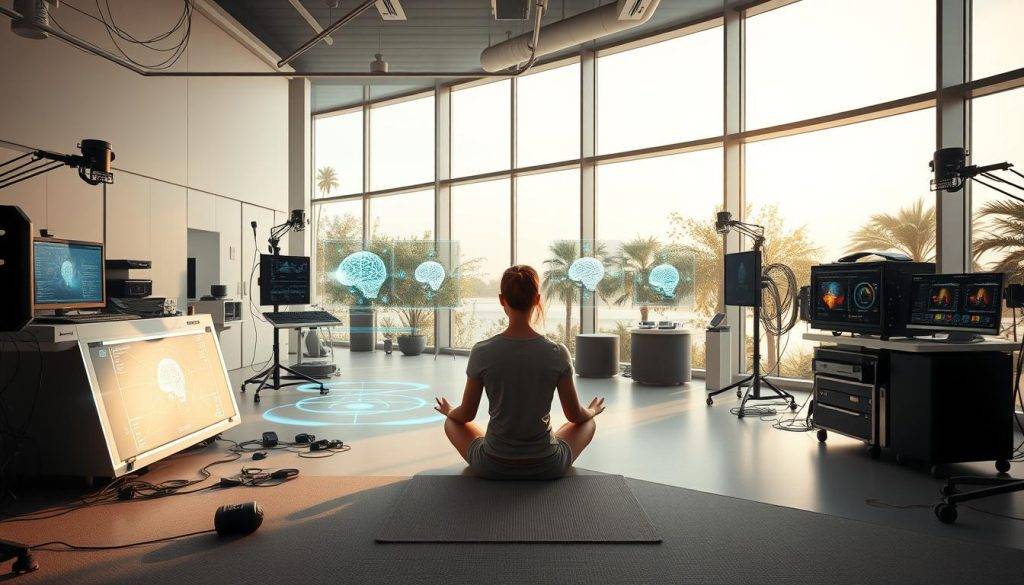
Cutting-edge technology now illuminates what ancient traditions called “awakening.” Harvard Medical School researchers recently mapped brain activity during cessation events—moments when thought patterns temporarily dissolve. Their findings reveal synchronized gamma waves in regions linked to self-awareness, offering clues about how sustained practice reshapes consciousness.
Bridging Ancient Wisdom With Modern Tools
Innovative studies at Brown University use real-time fMRI to guide practitioners into deeper states. Participants learn to modulate neural activity tied to distraction—a fusion of tech and tradition. As one neuroscientist notes: “We’re not replacing teachers; we’re creating maps for the journey.”
Massachusetts General Hospital trials explore energy shifts during concentrative absorption. Advanced EEG caps detect unique theta wave patterns in seasoned meditators—markers that could personalize training programs. These tools help teachers refine methods for students struggling with specific challenges.
Emerging applications stretch beyond traditional practice:
- VR environments simulating retreat conditions for home users
- Wearables providing biofeedback during daily tasks
- AI analysis of breath patterns to predict optimal session timing
Such innovations don’t diminish the experience—they deepen accessibility. As digital tools evolve, even brief daily sessions may yield insights once requiring years of isolation. The next frontier? Combining neurofeedback with compassionate inquiry to accelerate emotional healing.
Research centers now collaborate with monasteries, blending millennia-old techniques with 21st-century science. This partnership could unlock new understandings of enlightenment—not as a distant goal, but as a natural part of human potential. Your practice today contributes to this unfolding discovery, one breath at a time.
Conclusion
True growth in practice emerges not from grand gestures, but through steady commitment to the present moment. Ancient teachings and modern science agree—consistent effort reshapes how we engage with our thoughts, environment, and inner rhythms. Studies confirm what dedicated meditators experience: daily sessions strengthen neural pathways for focus and emotional balance.
The benefits extend beyond cushion time. Each mindful breath practiced amid life’s chaos builds awareness that transforms ordinary moments. Challenges like distractions or self-doubt become teachers, revealing your ability to return to stillness again and again.
Start small. A five-minute morning ritual or evening reflection can ignite profound shifts over weeks. As one teacher reminds us: “The journey isn’t about perfection—it’s showing up, breath by breath, to meet life fully.”
Ready to deepen your path? Explore retreats or guided sessions that resonate with your goals. Every step taken today plants seeds for a clearer, more centered tomorrow—one breath at a time.
























































